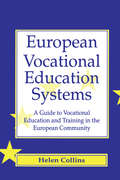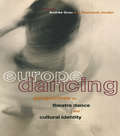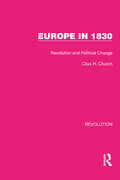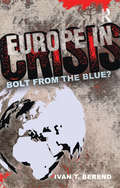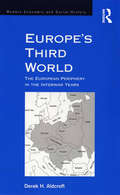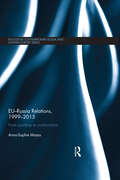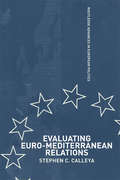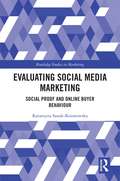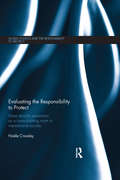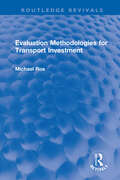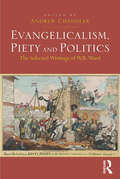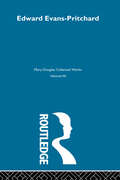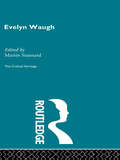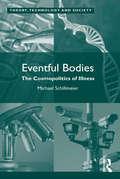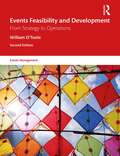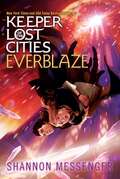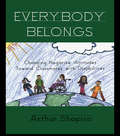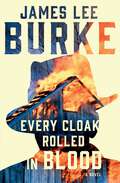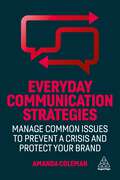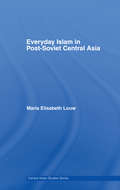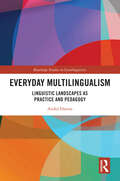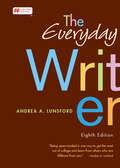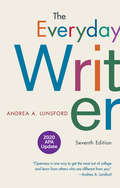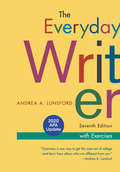Special Collections
Benetech’s Global Certified Accessible Titles
Description: Benetech’s GCA program is the first independent third-party EPUB certification to verify ebook accessibility. By creating content that is born accessible, publishers can meet the needs of all readers. Learn more: https://bornaccessible.benetech.org/
- Table View
- List View
European Vocational Educational Systems
by Collins, HelenThis detailed reference work describes the vocational training systems available in EC member states. It deals with the vocational qualification systems within each country and outlines EC programmes that promote the recognition of training schemes.
Europe Dancing
by Andree Grau and Stephanie JordanEurope Dancing examines the dance cultures and movements which have developed in Europe since the Second World War. Nine countries are represented in this unique collaboration between European dance scholars. The contributors chart the art form, and discuss the outside influences which have shaped it. This comprehensive book explores: * questions of identity within individual countries, within Europe, and in relation to the USA * the East/West cultural division * the development of state subsidy for dance * the rise of contemporary dance as an 'alternative' genre * the implications for dance of political, economic and social change. Useful historical charts are included to trace significant dance and political events throughout the twentieth century in each country. Never before has this information been gathered together in one place. This book is essential reading for everyone interested in dance and its growth and development in recent years.
Europe in 1830
by Clive H. ChurchThis book, first published in 1983, is a valuable corrective to the lack of academic research on the events of 1830 – a year of revolutions across the continent of Europe. Social protests and political changes are examined to note the causes of the political turmoil and revolution in 1830, and then the results of the revolutions’ developments are analysed, as general European social, political and diplomatic crises as well as a series of individual outbreaks. The book also turns to comparative study to look at the hows and wherefores of the revolutions, as the dynamics, participants and effects of revolution are examined in turn.
Europe in Crisis
by Ivan BerendThis book analyzes the European Great Recession of 2008-12, its economic and social causes, its historical roots, and the policies adopted by the European Union to find a way out of it. It contains explicit debates with several economists and analysts on some of the most controversial questions about the causes of the crisis and the policies applied by the European Union. It presents the cases of Iceland, Greece and Ireland, the countries that first declined into crisis in Europe, each of them in a different way. Iceland is a case study for reckless banking practices, Greece of reckless public spending, and Ireland of reckless household indebtedness. At least seven other countries, mostly from the peripheries of Europe, had similarly reckless banking and spending practices. In the center of the book are the economic and social causes of the crisis. Contemporary advanced capitalism became financialized, de-industrialized and globalized and got rid of the "straitjacket" of regulations. Solid banking was replaced by high-risk, "casino-type" activity. The European common currency also had a structural problem — monetary unification without a federal state and fiscal unification. The other side of the same coin is European hyper-consumerism. A new lifestyle emerged during two super-prosperous periods in the 1950s to 1960s, and during the 1990s to 2006. Trying to find an exit policy, the European Union turned to strict austerity measures to curb the budget deficit and indebtedness. This book critically analyzes the debate around austerity policy. The creation of important supra-national institutions, and of a financial supervisory authority and stability mechanisms, strengthens integration. The correction of the euro’s structural mistake by creating a quasi-fiscal unification is even more important. The introduction of mandatory fiscal rules and their supervision promises a long-term solution for a well-functioning common currency. These measures, meanwhile, create a two-tier European Union with a fast-track core. This book suggests that the European Union will emerge stronger from the crisis. This book will be of particular interest to students and researchers of economics, history, political science and international finance, but will also prove profitable reading for practitioners and the interested public.
Europe's Third World
by Derek H. AldcroftEconomic historians have perennially addressed the intriguing question of comparative development, asking why some countries develop much faster and further than others. Focusing primarily on Europe between 1914 and 1939, this present volume explores the development of thirteen countries that could be said to be categorised as economically backward during this period: Albania, Bulgaria, Estonia, Greece, Hungary, Latvia, Lithuania, Poland, Portugal, Romania, Spain, Turkey and Yugoslavia. These countries are linked, not only in being geographically on Europe's periphery, but all shared high agrarian components and income levels much lower than those enjoyed in western European countries. The study shows that by 1918 many of these countries had structural characteristics which either relegated them to a low level of development or reflected their economic backwardness, characteristics that were not helped by the hostile economic climate of the interwar period. It explores, region by region, how their progress was checked by war and depression, and how the effects of political and social factors could also be a major impediment to sustained progress and modernisation. For example, in many cases political corruption and instability, deficient administrations, ethnic and religious diversity, agrarian structures and backwardness, population pressures, as well as international friction, were retarding factors. In all this study offers a fascinating insight into many areas of Europe that are often ignored by economists and historians. It demonstrates that these countries were by no means a lost cause, and that their post-war performances show the latent economic potential that most harboured. By providing an insight into the development of Europe's 'periphery' a much more rounded and complete picture of the continent as a whole is achieved.
EU-Russia Relations, 1999-2015
by Anna-Sophie MaassThis book traces the development of EU-Russia relations in recent years. It argues that a major factor influencing the relationship is the changing internal dynamics of both parties, in Russia’s case an increasingly authoritarian state, in the case of the EU an increasing coherence in its foreign policy as applied to former Soviet countries which Russia regarded as interference in its own sphere. The book considers the impact of conflicts in Kosovo, Chechnya, Georgia and Ukraine, discusses the changing internal situation in both Russia and the EU, including the difficulties in overcoming fragmentation in EU policy-making, and concludes by assessing how the situation is likely to develop.
Evaluating Euro-Mediterranean
by Stephen CalleyaFirst Published in 2004. Routledge is an imprint of Taylor & Francis, an informa company.
Evaluating Social Media Marketing
by Katarzyna Sanak-KosmowskaThis book is an innovative attempt to identify and analyse the processes related to social influence in online buying behaviour, with special attention given to the phenomenon of social proof, which is the basis of social media, recommendation marketing and word of mouth (WOM) marketing. It empirically verifies the factors which influence the effectiveness of social proof, as well as identifying relevant impact factors. Opening with a literature review of this concept from the perspective of social psychology, sociology and marketing, this interdisciplinary approach to the issue allows for an in-depth understanding of the mechanisms of the effective use of social proof in contemporary online marketing. Following this, in the context of theoretical considerations, the author analyses the social role and significance of social proof in the buying behaviours of online consumers. The second half of the book presents the results of the author’s quantitative and qualitative research of the effectiveness of social proof. The quantitative research verifies the hypotheses concerning the social role and significance of social proof in buying decisions and identifies the level of confidence in the opinions expressed by other web users. The qualitative research focuses on the empirical verification of the effectiveness of social proof mechanisms. Additionally, attention is given to sensitivity to social proof, i.e., the factors that increase the effectiveness of such messages, both from the sender’s and recipient’s perspective, as well as the forms and channels of communication. Written for scholars and researchers interested in the debate on the transparency of activities carried out by companies in the area of online marketing, the book’s detailed analysis of influence utilising both quantitative and qualitative studies may be of interest to a wider group of academics including economists, psychologists and sociologists.
Evaluating the Responsibility to Protect
by Noële CrossleyThis book evaluates the extent to which the Responsibility to Protect (R2P) has consolidated as a norm in international society. A consolidated norm in international society is defined here as a regularised pattern of behaviour that is widely accepted as appropriate within a given social context. The analysis is based on the assumption that the R2P could be regarded as a consolidated norm if it were applied consistently when genocide and other mass atrocities occur; and if international responses routinely conformed to the core principles inherent in the R2P: seeking government consent, multilateralism, prevention and regionalism. This book employs Finnemore and Sikkink’s norm lifecycle model to determine the putative norm’s degree of consolidation, with in-depth case studies of the international responses to crises in Darfur and Kenya serving to illuminate the findings. It advances the argument that, whilst the R2P had fully emerged as a prospective norm by 2005, it has not yet fully consolidated as an international norm. The R2P has been remarkably successful at pervading the international discourse but has been somewhat less successful at consistency in implementation in terms of adherence to its core principles as outlined above (the qualitative dimension of the R2P). Furthermore, it has been least successful, to date, in terms of consistency across cases in terms of resolve and tenacity. The volume concludes with a reflection on the norm's progress so far, and its prospects for further consolidation, assuming the R2P continues on its current trajectory. This book will be of much interest to students of the Responsibility to Protect, humanitarian intervention, international law, security studies and IR.
Evaluation Methodologies for Transport Investment
by Michael RoeOriginally published in 1987, this title reviews and evaluates the methodologies suitable for highway evaluation, along with the UK transport supplementary grant and TPP (Transport Policies and Programme) system. Examples of current UK practice are briefly described, with more details being given of the technique of priority ranking used in the case study area of the West Midlands. Multi criteria approaches are reviewed in chapter two. Chapter three looks at the choice of highway data input in the light of those available, and the practical structure of factorial analysis applied to the case study area. The book covers following issues: computer structure and requirements; highway problem data; referencing methods; site definition; and weighting methods. The results from this study are described and then analysed by classical factorial analysis. The implications of the technique for the TPP preparation process, for the derivation of priorities, and the highway evaluation process as a whole are given. Specific techniques, such as factorial analysis, bridge problem and bus aid ranking, highway capacity calculations and sensitivity testing, as well as the computer programs used (March and COBA) are described in greater detail in the appendices.
Evangelicalism, Piety and Politics
by Andrew ChandlerW.R. Ward was one of the most influential historians of modern religion to be found at work in Britain during the twentieth century. Across fifty years his writings provoked a major reconsideration by historians of the significance of religion in society and its importance in the contexts of political, cultural and intellectual life. Ward was, above all, an international scholar who did much to repudiate any settled understanding that religious history existed in merely national categories. In particular, he showed how much British and American religion owed to the insights of Continental European thought and experience. This book presents many of Ward’s most important articles and gives a picture of the character, and extraordinary breadth, of his work. Embracing studies of John Wesley and the development of Methodism at large, the ambitions of Evangelicals in an age of international mission, the place of mysticism in evolution of Protestantism and the relations of churches and secular powers in the twentieth century, Andrew Chandler concludes that it was in such scholarship that Ward 'quietly recast the picture that we have of the past and drew our attention towards a far greater, more difficult and more interesting, landscape.'
Evans-Pritchard
by Mary DouglasFirst published in 1980, this book provides an overview of E. E. Evans-Pritchard's approach to anthropology. His seminal works on the Azande and the Nuer had an immense impact on the field in Britain. He wrote these works in his thirties and forties, after which time he became chair of anthropology at Oxford. His pupils and colleagues from his days as the head of Institute of Social Anthropology went from Oxford to complete the institutional establishment of social anthropology. In this book Douglas links the development of her own theories to her training under Evans-Pritchard at the institute and to the close friendship that they forged in the years after.
Evelyn Waugh
by Martin StannardThis set comprises 40 volumes covering nineteenth and twentieth century European and American authors. These volumes will be available as a complete set, mini boxed sets (by theme) or as individual volumes. This second set compliments the first 68 voulme set of Critical Heritage published by Routledge in October 1995.
Eventful Bodies
by Michael SchillmeierDisrupting, questioning and altering the taken-for-granted ’cosmos’ of everyday life, the experiences of illness challenge the different ways in which social normalcy is remembered, maintained and expected. This book explores the manifold experiences of life threatening, infectious or non-curable illnesses that trouble the practices and relations of human and social life. Challenging a mere deficit-model of illness, it examines how the cosmopolitics of illness require and initiate an ethos that cares for difference and diversity. Eventful Bodies presents rich qualitative and ethnographic data alongside print and on-line media sources from Germany and North America, exploring case studies involving Alzheimer's disease, stroke and the global threat of infectious diseases such as SARS. The book engages with debates in cosmopolitics and exposes the agency of those overlooked by contemporary discourses of cosmopolitanism, thus developing a new theory of illness and delineating a novel empirical agenda and conceptual space for sociological and anthropological research. A rigorous examination of the changes wrought in the social world by illness and the implications of this for social and political theory, Eventful Bodies will appeal to sociologists, anthropologists, social and political theorists, geographers and scholars of science and technology studies, with interests in medical sociology, health, illness and the body.
Events Feasibility and Development
by William O'TooleEvents Feasibility and Development: From Strategy to Operations 2nd Edition outlines the best practice in event development and the global events sector. Tools and techniques from the first edition have been refined and expanded through their use in over 20 countries, including the USA, France, UAE, Malaysia and South Africa. These include strategy development and implementation, asset management, portfolio management, return on investment, management process mapping and the feasibility study. Fascinating current examples illustrate these professional management techniques. The second edition elaborates on the events sector maturity model as a measurement tool for cities, regions and countries. This has been tried and successfully tested in developing economies and assisted in the rapid development and sustainability of events in Dubai and many other destinations. Each chapter contains exhibits, questions, bullet points and clear explanations of the tools and techniques. Brand new material includes: A full explanation of the maturity model including post-pandemic solutions New case studies and exhibits A new section on teaching and training in event management The chapters are fully supported by further current case studies and examples on the publisher’s and the author’s website. Online material also includes 11 lesson plans for a semester course, containing assessment items, learning objectives and teaching tips for each topic, and event photos and author videos explaining the topics. This will be essential reading for all students of Event Management.
Everblaze
by Shannon MessengerA New York Times bestselling series A USA TODAY bestselling series A California Young Reader Medal–winning series Sophie uncovers shocking secrets—and faces treacherous new enemies—in this electrifying third book in the Keeper of the Lost Cities series.Sophie Foster is ready to fight back. Her talents are getting stronger, and with the elusive Black Swan group ignoring her calls for help, she’s determined to find her kidnappers—before they come after her again. But a daring mistake leaves her world teetering on the edge of war, and causes many to fear that she has finally gone too far. And the deeper Sophie searches, the farther the conspiracy stretches, proving that her most dangerous enemy might be closer than she realizes. In this nail-biting third book in the Keeper of the Lost Cities series, Sophie must fight the flames of rebellion, before they destroy everyone and everything she loves.
Everybody Belongs
by Arthur ShapiroThe evil prosthesis of Captain Hook, the comical speech of Porky Pig, and the bumbling antics of Mr. Magoo are all examples of images in our culture which can become the basis of negative attitudes and subliminal prejudice towards persons with disabilities. These attitudes influence and underlie discriminatory acts, resulting in negative treatment and segregation. A teacher's ability to recognize and counter such images may well determine the success of inclusion and mainstreaming programs in our schools and society. Well-researched and well-written, this book offers practical guidance as grounded in solid research to schools that are wrestling with how to mainstream children with disabilities.
Every Cloak Rolled in Blood
by James Lee BurkeIn his most autobiographical novel to date, James Lee Burke continues the epic Holland family saga with a writer grieving the death of his daughter while battling earthly and supernatural outlaws.Novelist Aaron Holland Broussard is shattered when his daughter Fannie Mae dies suddenly. As he tries to honor her memory by saving two young men from a life of crime amid their opioid-ravaged community, he is drawn into a network of villainy that includes a violent former Klansman, a far-from-holy minister, a biker club posing as evangelicals, and a murderer who has been hiding in plain sight. Aaron&’s only ally is state police officer Ruby Spotted Horse, a no-nonsense woman who harbors some powerful secrets in her cellar. Despite the air of mystery surrounding her, Ruby is the only one Aaron can trust. That is, until the ghost of Fannie Mae shows up, guiding her father through a tangled web of the present and past and helping him vanquish his foes from both this world and the next. Drawn from James Lee Burke&’s own life experiences, Every Cloak Rolled in Blood is a devastating exploration of the nature of good and evil and a deeply moving story about the power of love and family.
Everyday Communication Strategies
by Amanda ColemanProtect your brand's reputation and maintain public confidence by successfully managing everyday incidents and issues and preventing them from escalating into a corporate crisis.For most companies and communicators, dealing with a full-blown crisis is few and far-between. But there are still everyday problems, challenges and incidents to be faced, including customer complaints,campaign failure, staff comments and online criticism. Everyday Communication Strategies shows how to effectively contain these emerging situations and prevent them from destabilizing your business and damaging consumer confidence. It provides a blueprint to help you move from identification to intervention to action. The book explores how to develop appropriate messaging, work with the media and manage social media to minimize negative publicity. It also explains how to build resilience and make effective decisions under pressure.The book contains tips, checklists and flowcharts, as well as a range of case studies and examples from organizations including KPMG, Jo Malone and General Mills. Everyday Communication Strategies is an indispensable guide to averting a crisis and preventing your business or brand from being plunged into a reputational storm.
Everyday Islam in Post-Soviet Central Asia
by Maria Elisabeth LouwProviding a wealth of empirical research on the everyday practise of Islam in post-Soviet Central Asia, this book gives a detailed account of how Islam is understood and practised among ordinary Muslims in the region, focusing in particular on Uzbekistan. It shows how individuals negotiate understandings of Islam as an important marker for identity, grounding for morality and as a tool for everyday problem-solving in the economically harsh, socially insecure and politically tense atmosphere of present-day Uzbekistan. Presenting a detailed case-study of the city of Bukhara that focuses upon the local forms of Sufism and saint veneration, the book shows how Islam facilitates the pursuit of more modest goals of agency and belonging, as opposed to the utopian illusions of fundamentalist Muslim doctrines.
Everyday Law for Seniors
by Lawrence A. Frolik and Linda S. WhittonAn essential resource, Everyday Law for Seniors provides easy-to-understand information for readers who want to make the best possible decisions about retirement options, health care, where to live, and planning for long-term care. Frolik and Whitton, national experts in elder law, explain the wide range of legal rights and benefits that every senior should consider, whether looking ahead or responding to a crisis. Updated with the latest federal benefit information and a host of helpful internet resources, this timely book is for everyone who wants to get the most from their senior years.
Everyday Multilingualism
by Anikó HatossHatoss explores multilingualism in diverse suburbs of Sydney through the oral and written narratives of student ethnographers. Her research is based on visual ethnography, interviews with local residents and classroom discussions of the fieldwork. The findings of this book contribute to the scholarship of sociolinguistics of globalisation and seek to enhance our understanding of the complex interrelationship between the linguistic landscape and its participants: how language choices are negotiated, how identity and ideologies shape interactions in everyday contexts of the urban landscape. The narrative approach provides a multi-layered analysis to better understand the micro and macro connections shaping everyday interactions, conviviality and social relations. Hatoss offers methodological and pedagogical insights into the development of global citizenship and intercultural competence through the experiential learning provided by the linguistic landscape project. This volume is a useful source for researchers working in diverse fields of multilingualism, diaspora studies, narratives and digital ethnographies in sociolinguistics. It offers methodological insights to the study of urban multilingualism and pedagogical insights into using linguistic landscapes for developing intercultural competence.
The Everyday Writer
by Andrea A. LunsfordThe Everyday Writer equips you to make informed writing choices for your courses, your career, and your community while also providing all of the writing resources you need in an engaging and highly-visual handbook.
The Everyday Writer
by Andrea A. LunsfordEmpowering and inspiring, Andrea Lunsford offers a handbook for our times. The Everyday Writer, Seventh Edition, invites students to think rhetorically, communicate ethically, listen respectfully, experiment with language, and adopt openness as a habit of mind necessary for democracy. The seventh edition introduces new chapters on college expectations and on language and identity as well as substantial new advice for reading and interrogating sources, seeking common ground with opponents, using varieties of English, and being open to new approaches in common academic genres. New student models of rhetorical analysis, researched argument, speech, and translingual narrative invigorate the book. As always, Lunsford’s Top Twenty--now its own tabbed section--serves as a guide for building students’ confidence as editors of their own writing.
The Everyday Writer with Exercises
by Andrea LunsfordWith 2020 APA Update. Empowering and inspiring, Andrea Lunsford offers a handbook for our times. The Everyday Writer with Exercises, Seventh Edition, invites students to think rhetorically, communicate ethically, listen respectfully, experiment with language, and adopt openness as a habit of mind necessary for democracy. The seventh edition introduces new chapters on college expectations and on language and identity as well as substantial new advice for reading and interrogating sources, seeking common ground with opponents, using varieties of English, and being open to new approaches in common academic genres. New student models of rhetorical analysis, researched argument, speech, and translingual narrative invigorate the book. As always, Lunsford’s Top Twenty--now its own tabbed section--serves as a guide for building students’ confidence as editors of their own writing.
